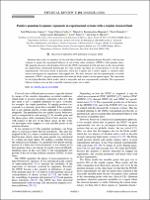Please use this identifier to cite or link to this item:
https://hdl.handle.net/20.500.12202/6435Full metadata record
| DC Field | Value | Language |
|---|---|---|
| dc.contributor.author | Santos, Lea F. | - |
| dc.contributor.author | Pilatowsky-Cameo, Saúl | - |
| dc.contributor.author | Chávez-Carlos, Jorge | - |
| dc.contributor.author | Bastarrachea-Magnani, Miguel A. | - |
| dc.contributor.author | Stránský, Pavel | - |
| dc.contributor.author | Hirsch, Jorge G. | - |
| dc.date.accessioned | 2020-11-18T19:53:39Z | - |
| dc.date.available | 2020-11-18T19:53:39Z | - |
| dc.date.issued | 2020-01-22 | - |
| dc.identifier.citation | Santos, Lea F., Saúl Pilatowsky-Cameo, Jorge Chávez-Carlos, Miguel A. Bastarrachea-Magnani, Pavel Stránský, Sergio Lerma-Hernández, and Jorge G. Hirsch. (22 January 2020). Positive quantum Lyapunov exponents in experimental systems with a regular classical limit. Phys. Rev. E 101, 010202(R) | en_US |
| dc.identifier.issn | 1550-2376 | - |
| dc.identifier.uri | https://doi.org/10.1103/PhysRevE.101.010202 | en_US |
| dc.identifier.uri | https://hdl.handle.net/20.500.12202/6435 | - |
| dc.description | Research article/ peer-reviewed. Open-Access. | en_US |
| dc.description.abstract | Quantum chaos refers to signatures of classical chaos found in the quantum domain. Recently, it has become common to equate the exponential behavior of out-of-time order correlators (OTOCs) with quantum chaos. The quantum-classical correspondence between the OTOC exponential growth and chaos in the classical limit has indeed been corroborated theoretically for some systems and there are several projects to do the same experimentally. The Dicke model, in particular, which has a regular and a chaotic regime, is currently under intense investigation by experiments with trapped ions. We show, however, that for experimentally accessible parameters, OTOCs can grow exponentially also when the Dicke model is in the regular regime. The same holds for the Lipkin-Meshkov-Glick model, which is integrable and also experimentally realizable. The exponential behavior in these cases are due to unstable stationary points, not to chaos. | en_US |
| dc.description.sponsorship | Acknowledgments.We thank J. Dale for helping us with the proof of Eq. (S4) in the SM [49], and E. Palacios, L. Díaz,and E. Murrieta of the Computation Center–ICN for their support. M.A.B.M. is grateful to J. D. Urbina and K. Richter for their hospitality and the opportunity for the exchange of ideas. P.S. is grateful to P. Cejnar for stimulating discussions.We acknowledge financial support from Mexican CONACYT Project No. CB2015-01/255702 and DGAPA, UNAM Project No. IN109417. P.S. is supported by the Charles University Research Center UNCE/SCI/013. L.F.S. is supported by NSFGrant No. DMR-1603418. L.F.S. and J.G.H. acknowledge the hospitality of the Aspen Center for Physics and the Simons Center for Geometry and Physics at Stony Brook University,where some of the research for this Rapid Communication was performed | en_US |
| dc.language.iso | en_US | en_US |
| dc.publisher | American Physical Society | en_US |
| dc.relation.ispartofseries | Physical Review Research;101 | - |
| dc.rights | Attribution-NonCommercial-NoDerivs 3.0 United States | * |
| dc.rights.uri | http://creativecommons.org/licenses/by-nc-nd/3.0/us/ | * |
| dc.subject | chaos | en_US |
| dc.subject | quantum chaos | en_US |
| dc.subject | trapped ions | en_US |
| dc.subject | Dicke model | en_US |
| dc.title | Positive quantum Lyapunov exponents in experimental systems with a regular classical limit. | en_US |
| dc.type | Article | en_US |
| dc.contributor.orcid | 0000-0001-9400-2709 | |
| local.yu.facultypage | https://www.yu.edu/faculty/pages/santos-lea | |
| Appears in Collections: | Stern College for Women -- Faculty Publications | |
Files in This Item:
| File | Description | Size | Format | |
|---|---|---|---|---|
| Santos Positive quantum 2020 PhysRevE.101.010202.pdf | 547.31 kB | Adobe PDF |  View/Open |
This item is licensed under a Creative Commons License

